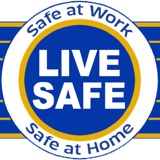Information
-
Document No.
-
Site
-
Conducted on
-
Prepared by
Safety Programs
-
Hazard tracking log being worked.
-
Who is responsible for fix?
- Facility MX
- Local Leadership (AO)
- Local Leadership (LM)
- Local Leadership (MM)
- Local Leadership (IF)
- Local Leadership (FO)
- Airport Authority
- Ground Equipment Maintenance (GQ)
-
Safety meeting minutes avalible
-
Who is responsible for fix?
- Facility MX
- Local Leadership (AO)
- Local Leadership (LM)
- Local Leadership (MM)
- Local Leadership (IF)
- Local Leadership (FO)
- Airport Authority
- Ground Equipment Maintenance (GQ)
-
Evacuation routes posted
-
Who is responsible for fix?
- Facility MX
- Local Leadership (AO)
- Local Leadership (LM)
- Local Leadership (MM)
- Local Leadership (IF)
- Local Leadership (FO)
- Airport Authority
- Ground Equipment Maintenance (GQ)
-
OHSA Postings and OSHA logs (if applicable)
-
Who is responsible for fix?
- Facility MX
- Local Leadership (AO)
- Local Leadership (LM)
- Local Leadership (MM)
- Local Leadership (IF)
- Local Leadership (FO)
- Airport Authority
- Ground Equipment Maintenance (GQ)
Fire prevention and Emergency Action Plan.
-
Flammable materials are stored in the correct fire cabinets
-
Who is responsible for fix?
- Facility MX
- Local Leadership (AO)
- Local Leadership (LM)
- Local Leadership (MM)
- Local Leadership (IF)
- Local Leadership (FO)
- Airport Authority
- Ground Equipment Maintenance (GQ)
-
Flammable cabinets are in good operating condition.
-
Who is responsible for fix?
- Facility MX
- Local Leadership (AO)
- Local Leadership (LM)
- Local Leadership (MM)
- Local Leadership (IF)
- Local Leadership (FO)
- Airport Authority
- Ground Equipment Maintenance (GQ)
-
Exit route are clear and unobstructed.
-
Who is responsible for fix?
- Facility MX
- Local Leadership (AO)
- Local Leadership (LM)
- Local Leadership (MM)
- Local Leadership (IF)
- Local Leadership (FO)
- Airport Authority
- Ground Equipment Maintenance (GQ)
-
Emergency exits are lit by emergency lighting and self-illuminated exit signs.
-
Who is responsible for fix?
- Facility MX
- Local Leadership (AO)
- Local Leadership (LM)
- Local Leadership (MM)
- Local Leadership (IF)
- Local Leadership (FO)
- Airport Authority
- Ground Equipment Maintenance (GQ)
-
Fire extinguishers are in good condition, not blocked, and are being checked once per month.
-
Who is responsible for fix?
- Facility MX
- Local Leadership (AO)
- Local Leadership (LM)
- Local Leadership (MM)
- Local Leadership (IF)
- Local Leadership (FO)
- Airport Authority
- Ground Equipment Maintenance (GQ)
-
Personal space heaters cause fires and are not in the facility.
-
Who is responsible for fix?
- Facility MX
- Local Leadership (AO)
- Local Leadership (LM)
- Local Leadership (MM)
- Local Leadership (IF)
- Local Leadership (FO)
- Airport Authority
- Ground Equipment Maintenance (GQ)
-
Compressed gas cylinders are kept away from heat and are restrained to prevent tipping or rolling.
-
Who is responsible for fix?
- Facility MX
- Local Leadership (AO)
- Local Leadership (LM)
- Local Leadership (MM)
- Local Leadership (IF)
- Local Leadership (FO)
- Airport Authority
- Ground Equipment Maintenance (GQ)
-
If a room is sprinkled, the system will not work if there is less than 18" vertical clearance between the sprinkler head and materials below.
-
Who is responsible for fix?
- Facility MX
- Local Leadership (AO)
- Local Leadership (LM)
- Local Leadership (MM)
- Local Leadership (IF)
- Local Leadership (FO)
- Airport Authority
- Ground Equipment Maintenance (GQ)
Housekeeping and Walking/working surfaces
-
Storage of materials must not create a hazard.
-
Who is responsible for fix?
- Facility MX
- Local Leadership (AO)
- Local Leadership (LM)
- Local Leadership (MM)
- Local Leadership (IF)
- Local Leadership (FO)
- Airport Authority
- Ground Equipment Maintenance (GQ)
-
Walking and working surfaces must be kept in a clean and safe condition.
-
Who is responsible for fix?
- Facility MX
- Local Leadership (AO)
- Local Leadership (LM)
- Local Leadership (MM)
- Local Leadership (IF)
- Local Leadership (FO)
- Airport Authority
- Ground Equipment Maintenance (GQ)
-
Shelving systems must be in good condition, anchored, and free of damage. Industrial systems must be load rated and placarded.
-
Who is responsible for fix?
- Facility MX
- Local Leadership (AO)
- Local Leadership (LM)
- Local Leadership (MM)
- Local Leadership (IF)
- Local Leadership (FO)
- Airport Authority
- Ground Equipment Maintenance (GQ)
-
Any platform higher then 4 feet (3 in California) must be guarded against falls.
-
Who is responsible for fix?
- Facility MX
- Local Leadership (AO)
- Local Leadership (LM)
- Local Leadership (MM)
- Local Leadership (IF)
- Local Leadership (FO)
- Airport Authority
- Ground Equipment Maintenance (GQ)
-
Unguarded holes, trip hazards, ledges, or anything else that could cause a slip, trip, or fall, must be guarded, covered, or otherwise protected.
-
Who is responsible for fix?
- Facility MX
- Local Leadership (AO)
- Local Leadership (LM)
- Local Leadership (MM)
- Local Leadership (IF)
- Local Leadership (FO)
- Airport Authority
- Ground Equipment Maintenance (GQ)
Hazard Communication
-
All co-workers who work with chemicals know how to access the MSDS or SDS.
-
Who is responsible for fix?
- Facility MX
- Local Leadership (AO)
- Local Leadership (LM)
- Local Leadership (MM)
- Local Leadership (IF)
- Local Leadership (FO)
- Airport Authority
- Ground Equipment Maintenance (GQ)
-
Eye was stations and showers are in good condition, are functional, and are checked for operation once a month.
-
Who is responsible for fix?
- Facility MX
- Local Leadership (AO)
- Local Leadership (LM)
- Local Leadership (MM)
- Local Leadership (IF)
- Local Leadership (FO)
- Airport Authority
- Ground Equipment Maintenance (GQ)
-
All secondary containers are labeled with the name of the chemical within (sharpie marker is suitable). This must be done for non-hazardous chemicals as well (such as water).
-
Who is responsible for fix?
- Facility MX
- Local Leadership (AO)
- Local Leadership (LM)
- Local Leadership (MM)
- Local Leadership (IF)
- Local Leadership (FO)
- Airport Authority
- Ground Equipment Maintenance (GQ)
-
Any place where working with corrosive materials, such as battery charging and maintenance locations, have a plumbed eyewash near by.
-
Who is responsible for fix?
- Facility MX
- Local Leadership (AO)
- Local Leadership (LM)
- Local Leadership (MM)
- Local Leadership (IF)
- Local Leadership (FO)
- Airport Authority
- Ground Equipment Maintenance (GQ)
Electrical safety
-
Electrical panels must be clear of obstruction, have easy access, and the door must be closed.
-
Who is responsible for fix?
- Facility MX
- Local Leadership (AO)
- Local Leadership (LM)
- Local Leadership (MM)
- Local Leadership (IF)
- Local Leadership (FO)
- Airport Authority
- Ground Equipment Maintenance (GQ)
-
Extension cords used as permanent wiring must be removed. Daisy chaining (plugging and extension cord into another extension cord) is never safe.
-
Who is responsible for fix?
- Facility MX
- Local Leadership (AO)
- Local Leadership (LM)
- Local Leadership (MM)
- Local Leadership (IF)
- Local Leadership (FO)
- Airport Authority
- Ground Equipment Maintenance (GQ)
-
Electrical cords must be protected from accidental damage and be removed if found to have damage.
-
Who is responsible for fix?
- Facility MX
- Local Leadership (AO)
- Local Leadership (LM)
- Local Leadership (MM)
- Local Leadership (IF)
- Local Leadership (FO)
- Airport Authority
- Ground Equipment Maintenance (GQ)
-
Lightning fixtures less than 7 feet from the floor or in storage areas should be covered/guarded.
-
Who is responsible for fix?
- Facility MX
- Local Leadership (AO)
- Local Leadership (LM)
- Local Leadership (MM)
- Local Leadership (IF)
- Local Leadership (FO)
- Airport Authority
- Ground Equipment Maintenance (GQ)
-
All appliances (coffee makers, refrigerators, toasters, etc) must be plugged directly into the wall.
-
Who is responsible for fix?
- Facility MX
- Local Leadership (AO)
- Local Leadership (LM)
- Local Leadership (MM)
- Local Leadership (IF)
- Local Leadership (FO)
- Airport Authority
- Ground Equipment Maintenance (GQ)
-
All pull boxes, junction boxes, switches, and outlets must be covered. Pull boxes and junction boxes must also be labeled.
-
Who is responsible for fix?
- Facility MX
- Local Leadership (AO)
- Local Leadership (LM)
- Local Leadership (MM)
- Local Leadership (IF)
- Local Leadership (FO)
- Airport Authority
- Ground Equipment Maintenance (GQ)
Lock Out Tag Out (LOTO)
-
If we are trained to clear bag jams, LOTO procedures should be used and trained. If we depend on an outside company to clear bag jams, we should be trained on what a LOTO tag looks like and how we should never attempt to remove it.
-
Who is responsible for fix?
- Facility MX
- Local Leadership (AO)
- Local Leadership (LM)
- Local Leadership (MM)
- Local Leadership (IF)
- Local Leadership (FO)
- Airport Authority
- Ground Equipment Maintenance (GQ)
Machine Gaurding
-
Exposed shafting, gears, and chains less than 7 feet from the floor or working platform must be guarded in the bag room or anywhere else on the property.
-
Who is responsible for fix?
- Facility MX
- Local Leadership (AO)
- Local Leadership (LM)
- Local Leadership (MM)
- Local Leadership (IF)
- Local Leadership (FO)
- Airport Authority
- Ground Equipment Maintenance (GQ)
Personal Protection Equipment (PPE)
-
Hearing protection is used in high noise areas.
-
Who is responsible for fix?
- Facility MX
- Local Leadership (AO)
- Local Leadership (LM)
- Local Leadership (MM)
- Local Leadership (IF)
- Local Leadership (FO)
- Airport Authority
- Ground Equipment Maintenance (GQ)
-
High visibility vests are used on the ramp and in low visibility areas such as some bag rooms.
-
Who is responsible for fix?
- Facility MX
- Local Leadership (AO)
- Local Leadership (LM)
- Local Leadership (MM)
- Local Leadership (IF)
- Local Leadership (FO)
- Airport Authority
- Ground Equipment Maintenance (GQ)












